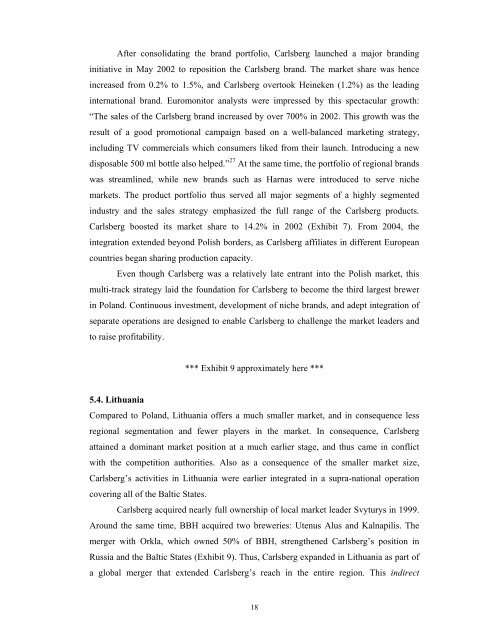Market Penetration and Acquisition Strategies for Emerging ...
Market Penetration and Acquisition Strategies for Emerging ...
Market Penetration and Acquisition Strategies for Emerging ...
Create successful ePaper yourself
Turn your PDF publications into a flip-book with our unique Google optimized e-Paper software.
After consolidating the br<strong>and</strong> portfolio, Carlsberg launched a major br<strong>and</strong>ing<br />
initiative in May 2002 to reposition the Carlsberg br<strong>and</strong>. The market share was hence<br />
increased from 0.2% to 1.5%, <strong>and</strong> Carlsberg overtook Heineken (1.2%) as the leading<br />
international br<strong>and</strong>. Euromonitor analysts were impressed by this spectacular growth:<br />
“The sales of the Carlsberg br<strong>and</strong> increased by over 700% in 2002. This growth was the<br />
result of a good promotional campaign based on a well-balanced marketing strategy,<br />
including TV commercials which consumers liked from their launch. Introducing a new<br />
disposable 500 ml bottle also helped.” 27 At the same time, the portfolio of regional br<strong>and</strong>s<br />
was streamlined, while new br<strong>and</strong>s such as Harnas were introduced to serve niche<br />
markets. The product portfolio thus served all major segments of a highly segmented<br />
industry <strong>and</strong> the sales strategy emphasized the full range of the Carlsberg products.<br />
Carlsberg boosted its market share to 14.2% in 2002 (Exhibit 7). From 2004, the<br />
integration extended beyond Polish borders, as Carlsberg affiliates in different European<br />
countries began sharing production capacity.<br />
Even though Carlsberg was a relatively late entrant into the Polish market, this<br />
multi-track strategy laid the foundation <strong>for</strong> Carlsberg to become the third largest brewer<br />
in Pol<strong>and</strong>. Continuous investment, development of niche br<strong>and</strong>s, <strong>and</strong> adept integration of<br />
separate operations are designed to enable Carlsberg to challenge the market leaders <strong>and</strong><br />
to raise profitability.<br />
*** Exhibit 9 approximately here ***<br />
5.4. Lithuania<br />
Compared to Pol<strong>and</strong>, Lithuania offers a much smaller market, <strong>and</strong> in consequence less<br />
regional segmentation <strong>and</strong> fewer players in the market. In consequence, Carlsberg<br />
attained a dominant market position at a much earlier stage, <strong>and</strong> thus came in conflict<br />
with the competition authorities. Also as a consequence of the smaller market size,<br />
Carlsberg’s activities in Lithuania were earlier integrated in a supra-national operation<br />
covering all of the Baltic States.<br />
Carlsberg acquired nearly full ownership of local market leader Svyturys in 1999.<br />
Around the same time, BBH acquired two breweries: Utenus Alus <strong>and</strong> Kalnapilis. The<br />
merger with Orkla, which owned 50% of BBH, strengthened Carlsberg’s position in<br />
Russia <strong>and</strong> the Baltic States (Exhibit 9). Thus, Carlsberg exp<strong>and</strong>ed in Lithuania as part of<br />
a global merger that extended Carlsberg’s reach in the entire region. This indirect<br />
18



